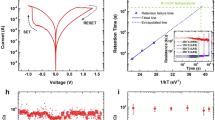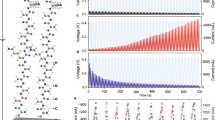Abstract
Memory is believed to occur in the human brain as a result of two types of synaptic plasticity: short-term plasticity (STP) and long-term potentiation (LTP; refs 1, 2, 3, 4). In neuromorphic engineering5,6, emulation of known neural behaviour has proven to be difficult to implement in software because of the highly complex interconnected nature of thought processes. Here we report the discovery of a Ag2S inorganic synapse, which emulates the synaptic functions of both STP and LTP characteristics through the use of input pulse repetition time. The structure known as an atomic switch7,8, operating at critical voltages, stores information as STP with a spontaneous decay of conductance level in response to intermittent input stimuli, whereas frequent stimulation results in a transition to LTP. The Ag2S inorganic synapse has interesting characteristics with analogies to an individual biological synapse, and achieves dynamic memorization in a single device without the need of external preprogramming. A psychological model related to the process of memorizing and forgetting is also demonstrated using the inorganic synapses. Our Ag2S element indicates a breakthrough in mimicking synaptic behaviour essential for the further creation of artificial neural systems that emulate characteristics of human memory.
This is a preview of subscription content, access via your institution
Access options
Subscribe to this journal
Receive 12 print issues and online access
$259.00 per year
only $21.58 per issue
Buy this article
- Purchase on Springer Link
- Instant access to full article PDF
Prices may be subject to local taxes which are calculated during checkout




Similar content being viewed by others
References
Bliss, T. V. P. & Collingridge, G. L. A synaptic model of memory: Long-term potentiation in the hippocampus. Nature 361, 31–39 (1993).
Kandel, E. R., Schwartz, J. H. & Jessell, T. M. (eds) Principles of Neural Science 4th edn (McGraw-Hill, 2000).
Martin, S. J., Grimwood, P. D. & Morris, R. G. M. Synaptic plasticity and memory: An evaluation of the hypothesis. Annu. Rev. Neurosci. 23, 649–711 (2000).
Whitlock, J. R., Heynen, A. J., Shuler, M. G. & Bear, M. F. Learning induces long-term potentiation in the hippocampus. Science 313, 1093–1097 (2006).
Douglas, R., Mahowald, M. & Mead, C. Neuromorphic analogue VLSI. Annu. Rev. Neurosci. 18, 255–281 (1995).
Hammerstrom, D. in Nanotechnology: Information Technology II (ed. Waser, R.) 251–285 (Wiley–VCH, 2008).
Terabe, K., Hasegawa, T., Nakayama, T. & Aono, M. Quantum point contact switch realized by solid electrochemical reaction. Riken Rev. 37, 7–8 (2001).
Terabe, K., Hasegawa, T., Nakayama, T. & Aono, M. Quantized conductance atomic switch. Nature 433, 47–50 (2005).
Tank, D. W. & Hopfield, J. J. Simple neural optimization networks: An A/D converter, signal decision circuit, and a linear programming circuit. IEEE Trans. Circuits Syst. 33, 533–541 (1986).
Chua, L. O. & Yang, L. Cellular neural networks: Applications. IEEE Trans. Circuits Syst. 35, 1273–1290 (1988).
Aihara, K., Takabe, T. & Toyoda, M. Chaotic neural networks. Phys. Lett. A 144, 333–340 (1990).
Mahowald, M. & Douglas, R. A silicon neuron. Nature 354, 515–518 (1991).
Ramacher, U. SYNAPSE—a neurocomputer that synthesizes neural algorithms on a parallel systolic engine. J. Parallel Distrib. Comput. 14, 306–318 (1992).
Ishiwara, H. Proposal of adaptive-learning neuron circuits with ferroelectric analog-memory weights. Jpn J. Appl. Phys. 32, 442–446 (1993).
Diorio, C., Hasler, P., Minch, B. A. & Mead, C. A. A single-transistor silicon synapse. IEEE Trans. Electron Devices 43, 1972–1980 (1996).
Akazawa, M. & Amemiya, Y. Boltzmann machine neuron circuit using single-electron tunnelling. Appl. Phys. Lett. 70, 670–672 (1997).
Hahnloser, R. H. R. et al. Digital selection and analogue amplification coexist in a cortex-inspired silicon circuit. Nature 405, 947–951 (2000).
Choi, T. Y. W. et al. Neuromorphic implementation of orientation hypercolumns. IEEE Trans. Circuits Syst. I 52, 1049–1060 (2005).
Indiveri, G., Chicca, E. & Douglas, R. A VLSI array of low-power spiking neurons and bistable synapses with spike-timing dependent plasticity. IEEE Trans. Neural Netw. 17, 211–221 (2006).
Wijekoon, J. H. B. & Dudek, P. Compact silicon neuron circuit with spiking and bursting behaviour. Neural Netw. 21, 524–534 (2008).
Waser, R. & Aono, M. Nanoionics-based resistive switching memories. Nature Mater. 6, 833–840 (2007).
Kozicki, M. N. & Mitkova, M. in Nanotechnology: Information Technology I (ed. Waser, R.) 485–515 (Wiley–VCH, 2008).
Yang, J. J. et al. Memristive switching mechanism for metal/oxide/metal nanodevices. Nature Nanotech. 3, 429–433 (2008).
Thakoor, S., Moopenn, A., Daud, T. & Thakoor, A. P. Solid-state thin-film memistor for electronic neural networks. J. Appl. Phys. 67, 3132–3135 (1990).
Jo, S. H. et al. Nanoscale memristor device as synapse in neuromorphic systems. Nano Lett. 10, 1297–1301 (2010).
Lai, Q. et al. Ionic/electronic hybrid materials integrated in a synaptic transistor with signal processing and learning functions. Adv. Mater. 22, 2448–2453 (2010).
Bi, G. Q. & Poo, M. M. Synaptic modifications in cultured hippocampal neurons: Dependence on spike timing, synaptic strength, and postsynaptic cell type. J. Neurosci. 18, 10464–10472 (1998).
Hasegawa, T. et al. Learning abilities achieved by a single solid-state atomic switch. Adv. Mater. 22, 1831–1834 (2010).
Hasegawa, T. et al. Memristive operations demonstrated by gap-type atomic switches. Appl. Phys. A 102, 811–815 (2011).
van Houten, H. & Beenakker, C. Quantum point contacts. Phys. Today 49, 22–27 (July, 1996).
Xu, Z. et al. Real-time in situ HRTEM-resolved resistance switching of Ag2S nanoscale ionic conductor. ACS Nano 4, 2515–2522 (2010).
Atkinson, R. C. & Shiffrin, R. M. in The Psychology of Learning and Motivation: Advances in Research and Theory Vol. 2 (eds Spence, K. W. & Spence, J. T.) 89–195 (Academic, 1968).
Ebbinghaus, H. in Memory: A Contribution to Experimental Psychology (eds trans. Ruger, H. A. & Bussenius, C. E.) (Teachers College, Columbia Univ., 1913).
Sala, S. D. (ed.) Forgetting (Psychology Press, 2010).
Rubin, D. C. & Wenzel, A. E. One hundred years of forgetting: A quantitative description of retention. Psychol. Rev. 103, 734–760 (1996).
Snider, G. S. Self-organized computation with unreliable, memristive nanodevices. Nanotechnology 18, 365202 (2007).
Turel, O. & Likharev, K. CrossNets: Possible neuromorphic networks based on nanoscale components. Int. J. Circ. Theor. Appl. 31, 37–53 (2003).
Kudo, T. & Fueki, K. Solid State Ionics (Kodansha/VCH, 1990).
Wysk, H. & Schmalzried, H. Electrochemical investigation of the α/β-phase transition of silver sulfide. Solid State Ion. 96, 41–47 (1997).
Acknowledgements
This research was supported in part by a MEXT grant (Key-Technology Research Project ‘Atomic Switch Programmed Device’) and by a JST grant (Strategic Japanese–German Cooperative Program). We thank A. Nayak for help with measurement of the retention time.
Author information
Authors and Affiliations
Contributions
T.O. and T.H. designed the experiments. T.O., T.H. and J.K.G. wrote the paper. T.O. also carried out the experiments and analysed the data. T.T. and K.T. contributed to the materials and analysis. All authors discussed the results and commented on the manuscript. T.H. and M.A. directed the projects.
Corresponding authors
Ethics declarations
Competing interests
The authors declare no competing financial interests.
Supplementary information
Supplementary Movie
Supplementary Movie (MOV 699 kb)
Supplementary Information
Supplementary Information (PDF 1347 kb)
Rights and permissions
About this article
Cite this article
Ohno, T., Hasegawa, T., Tsuruoka, T. et al. Short-term plasticity and long-term potentiation mimicked in single inorganic synapses. Nature Mater 10, 591–595 (2011). https://doi.org/10.1038/nmat3054
Received:
Accepted:
Published:
Issue Date:
DOI: https://doi.org/10.1038/nmat3054
This article is cited by
-
A scalable solution recipe for a Ag-based neuromorphic device
Discover Nano (2023)
-
Resistive random access memory: introduction to device mechanism, materials and application to neuromorphic computing
Discover Nano (2023)
-
Echo state graph neural networks with analogue random resistive memory arrays
Nature Machine Intelligence (2023)
-
Recent progress in three-terminal artificial synapses based on 2D materials: from mechanisms to applications
Microsystems & Nanoengineering (2023)
-
Bio-inspired artificial synapse for neuromorphic computing based on NiO nanoparticle thin film
Scientific Reports (2023)



